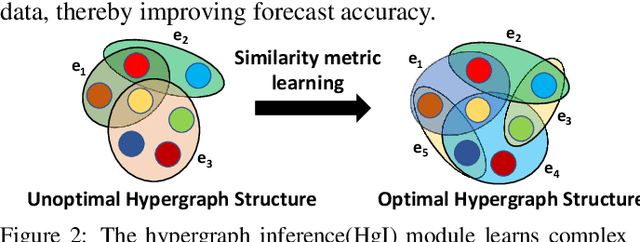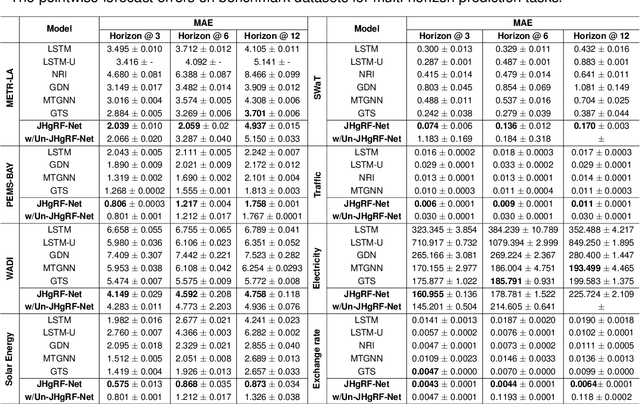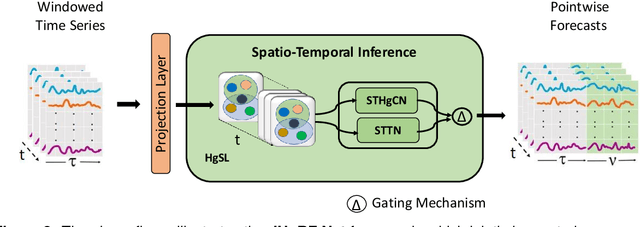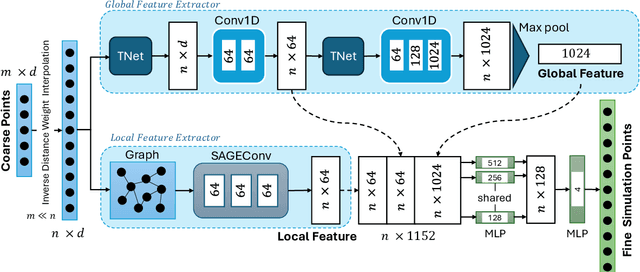Krishna Sai Sudhir Aripirala
Multi-Knowledge Fusion Network for Time Series Representation Learning
Aug 22, 2024Abstract:Forecasting the behaviour of complex dynamical systems such as interconnected sensor networks characterized by high-dimensional multivariate time series(MTS) is of paramount importance for making informed decisions and planning for the future in a broad spectrum of applications. Graph forecasting networks(GFNs) are well-suited for forecasting MTS data that exhibit spatio-temporal dependencies. However, most prior works of GFN-based methods on MTS forecasting rely on domain-expertise to model the nonlinear dynamics of the system, but neglect the potential to leverage the inherent relational-structural dependencies among time series variables underlying MTS data. On the other hand, contemporary works attempt to infer the relational structure of the complex dependencies between the variables and simultaneously learn the nonlinear dynamics of the interconnected system but neglect the possibility of incorporating domain-specific prior knowledge to improve forecast accuracy. To this end, we propose a hybrid architecture that combines explicit prior knowledge with implicit knowledge of the relational structure within the MTS data. It jointly learns intra-series temporal dependencies and inter-series spatial dependencies by encoding time-conditioned structural spatio-temporal inductive biases to provide more accurate and reliable forecasts. It also models the time-varying uncertainty of the multi-horizon forecasts to support decision-making by providing estimates of prediction uncertainty. The proposed architecture has shown promising results on multiple benchmark datasets and outperforms state-of-the-art forecasting methods by a significant margin. We report and discuss the ablation studies to validate our forecasting architecture.
Multi-Source Knowledge-Based Hybrid Neural Framework for Time Series Representation Learning
Aug 22, 2024



Abstract:Accurately predicting the behavior of complex dynamical systems, characterized by high-dimensional multivariate time series(MTS) in interconnected sensor networks, is crucial for informed decision-making in various applications to minimize risk. While graph forecasting networks(GFNs) are ideal for forecasting MTS data that exhibit spatio-temporal dependencies, prior works rely solely on the domain-specific knowledge of time-series variables inter-relationships to model the nonlinear dynamics, neglecting inherent relational structural dependencies among the variables within the MTS data. In contrast, contemporary works infer relational structures from MTS data but neglect domain-specific knowledge. The proposed hybrid architecture addresses these limitations by combining both domain-specific knowledge and implicit knowledge of the relational structure underlying the MTS data using Knowledge-Based Compositional Generalization. The hybrid architecture shows promising results on multiple benchmark datasets, outperforming state-of-the-art forecasting methods. Additionally, the architecture models the time varying uncertainty of multi-horizon forecasts.
Joint Hypergraph Rewiring and Memory-Augmented Forecasting Techniques in Digital Twin Technology
Aug 22, 2024



Abstract:Digital Twin technology creates virtual replicas of physical objects, processes, or systems by replicating their properties, data, and behaviors. This advanced technology offers a range of intelligent functionalities, such as modeling, simulation, and data-driven decision-making, that facilitate design optimization, performance estimation, and monitoring operations. Forecasting plays a pivotal role in Digital Twin technology, as it enables the prediction of future outcomes, supports informed decision-making, minimizes risks, driving improvements in efficiency, productivity, and cost reduction. Recently, Digital Twin technology has leveraged Graph forecasting techniques in large-scale complex sensor networks to enable accurate forecasting and simulation of diverse scenarios, fostering proactive and data-driven decision making. However, existing Graph forecasting techniques lack scalability for many real-world applications. They have limited ability to adapt to non-stationary environments, retain past knowledge, lack a mechanism to capture the higher order spatio-temporal dynamics, and estimate uncertainty in model predictions. To surmount the challenges, we introduce a hybrid architecture that enhances the hypergraph representation learning backbone by incorporating fast adaptation to new patterns and memory-based retrieval of past knowledge. This balance aims to improve the slowly-learned backbone and achieve better performance in adapting to recent changes. In addition, it models the time-varying uncertainty of multi-horizon forecasts, providing estimates of prediction uncertainty. Our forecasting architecture has been validated through ablation studies and has demonstrated promising results across multiple benchmark datasets, surpassing state-ofthe-art forecasting methods by a significant margin.
PointSAGE: Mesh-independent superresolution approach to fluid flow predictions
Apr 06, 2024



Abstract:Computational Fluid Dynamics (CFD) serves as a powerful tool for simulating fluid flow across diverse industries. High-resolution CFD simulations offer valuable insights into fluid behavior and flow patterns, aiding in optimizing design features or enhancing system performance. However, as resolution increases, computational data requirements and time increase proportionately. This presents a persistent challenge in CFD. Recently, efforts have been directed towards accurately predicting fine-mesh simulations using coarse-mesh simulations, with geometry and boundary conditions as input. Drawing inspiration from models designed for super-resolution, deep learning techniques like UNets have been applied to address this challenge. However, these existing methods are limited to structured data and fail if the mesh is unstructured due to its inability to convolute. Additionally, incorporating geometry/mesh information in the training process introduces drawbacks such as increased data requirements, challenges in generalizing to unseen geometries for the same physical phenomena, and issues with robustness to mesh distortions. To address these concerns, we propose a novel framework, PointSAGE a mesh-independent network that leverages the unordered, mesh-less nature of Pointcloud to learn the complex fluid flow and directly predict fine simulations, completely neglecting mesh information. Utilizing an adaptable framework, the model accurately predicts the fine data across diverse point cloud sizes, regardless of the training dataset's dimension. We have evaluated the effectiveness of PointSAGE on diverse datasets in different scenarios, demonstrating notable results and a significant acceleration in computational time in generating fine simulations compared to standard CFD techniques.
 Add to Chrome
Add to Chrome Add to Firefox
Add to Firefox Add to Edge
Add to Edge